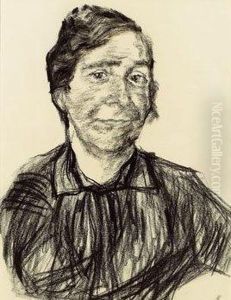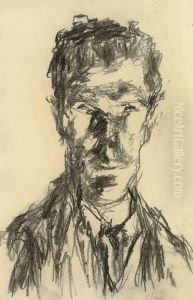Edmund Kalb Paintings
Edmund Kalb was an Austrian painter and graphic artist known for his expressive and sometimes grotesque works that often reflected his critical view of society and his inner turmoil. Born on May 15, 1900, in Dornbirn, Austria, Kalb grew up in a time of significant social and political change which would later influence his artistic career.
After serving in the First World War, Kalb studied at the School of Applied Arts in Vienna under the guidance of Anton von Kenner and Rudolf Jettmar. However, his artistic career was primarily self-taught, developing a distinct style that combined elements of Expressionism and New Objectivity. He was particularly influenced by the works of artists such as Egon Schiele and Oskar Kokoschka.
Kalb's oeuvre is characterized by a strong use of line and a tendency towards caricature, with many of his works focusing on the human figure, often depicted in a distorted and dramatic manner. This was reflective of his interest in the human condition and the psychological states that underpin it. His work often grappled with themes of alienation, anxiety, and the absurdity of human existence, which resonated with the post-war sentiment in Europe.
Despite his talent, Edmund Kalb struggled with mental health issues throughout his life, which affected his social standing and professional success. He was often on the margins of the art world, and his work was not widely recognized during his lifetime. Kalb's life was also marked by several tragic events, including family losses and personal setbacks, which further darkened the themes of his art.
The later years of his life were spent in and out of psychiatric institutions, and it was during these times that he produced some of his most poignant work. Kalb continued to paint until his health deteriorated, leading to his untimely death on October 24, 1952, in Dornbirn. It was only posthumously that Edmund Kalb's work began to be appreciated for its raw and honest portrayal of the human experience. Today, he is considered an important figure in Austrian art, with his works held in various collections and museums across the country.

